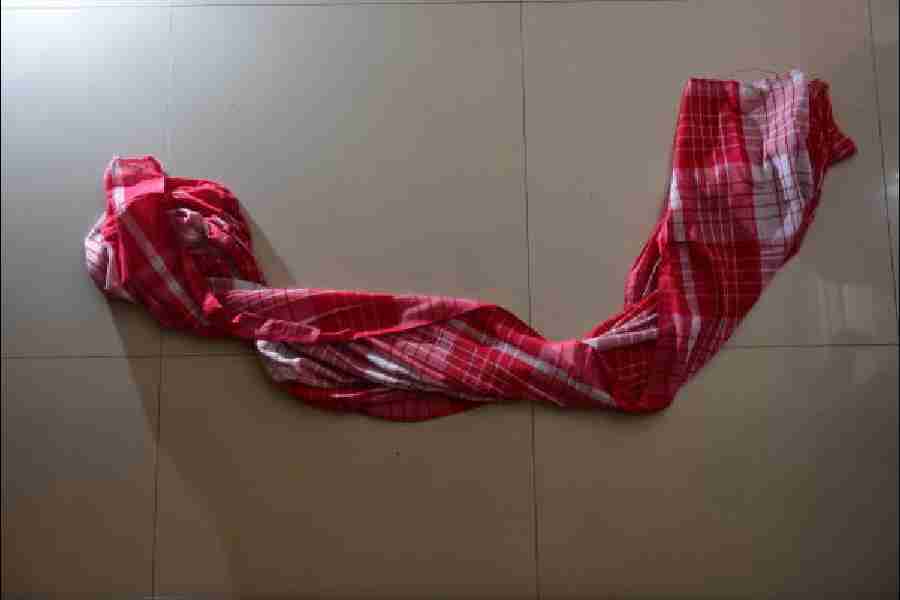Between the mid-1970s and late 1990s, in tiny places with quaint names such as Barabhum, Piska, Chandrapura and Muri in the arid zone that was the Bihar-Bengal border, my family and I learnt to live with water scarcity. My father was a railway track inspector and whenever he moved so did the whole family. Washing a towel required buckets of water, so our constant companion through these transfers was the gamchha.
Gamchha is the name for the indigenous chequered cotton towel. It is known as gamchha in Bengal and Bihar, gamuccha in Odisha andgamosa in Assam. Farmers and daily wage labourers use them come rain or shine.
The gamchha makes an appearance in oral tales, epics and classics of a geography as extensive as today’s Jharkhand in the west, to Chittagong in the east. Time and again we are reminded that the piece of cloth is a little more than a thing of utility. There are countless references to it in traditional folk songs right from the time of Charyapada, the earliest extant book of Bengali poems dating back to the 9th century. In Bijay Gupta’s epic Padmapuran, composed in 1494 AD, he mentions the gamchha while describing a marginal farmer’s attire. In the medieval classic Chaitanyamangal, the account of Chaitanya Mahaprabhu by Lochan Das, a devotee welcomes the saint home and fans him with a wet gamchha. In the Mangalkavya, a collection of medieval texts from the late 16th century, there are references to a corrupt bureaucrat called Bhanru Datt who used a gamchha to pack all the essentials — vegetables, rice, salt — he had earned by extortion.
The gamchha, however, became a marker of the marginal beginning the late 19th century, which is also when the towel entered upper-class households. Even now, babus in government offices are happy to drape the backs of their hot seat with a thick towel!
Writer-activist and Trinamul MLA, Manoranjan Byapari, once said to me, “Dalits like me know how handy this piece of cloth is. You can use it to wipe off the sweat after a hard day’s work. You can spread it on the ground, a railway platform or a footpath. Sleep on it or turn it into a pillow, or tie it on the head like a turban. Use it as a bag to tie a bundle of vegetables, foodgrains or any other dry ration. And, if required, you can turn it into a slingshot and aim at adversaries.” Byapari was half-jesting but 18th century thuggees of central India took the gamchha very seriously. They used it to strangle their victims before looting them.
Textile artiste Shafikul Kabir Chandan has written a book in Bengali that is meant to be a biography of the gamchha. Gamchha Charitkatha spans nearly three centuries.
Chandan, who moves between Milan (Italy), Loughborough (UK) and Narsingdi (Bangladesh), believes the gamchha originated in theancient civilisations of the IndusValley and Egypt.
He writes in his book, “It’s a pity that some master weavers today look down upon those in their own fraternity who weave gamchhas. For them, only impoverished sari weavers are forced to take up weaving checkered scarves to meet both ends. These elite weavers gloss over the fact that the basic crafting of a gamchha is not much different from the weaving of a fashionable sari or a dhoti.”
Chandan’s book is peppered with poems, songs, proverbs and a variety of literary references to the gamchha. The lyrics of the song Kajal Bhromora Re by Jasimuddin is among these; in it a young woman appeals to her lover who is moving far away in search of a job to leave his gamchha as a keepsake. No wedding ritual in these parts — be it among Hindus, Muslims or Buddhists — can be performed without the gamchha. It also features in funerary rituals.
The sanctum sanctorum of Vaishnav monasteries in Assam are adorned with gamosas and at the time of Bihu, dancers wear gamosas. For Chakma, Marma, Garo, Mech and other tribal communities, this is considered a sacred cloth. Leirum Phee, which is the traditional scarf of Manipur, is among the most beautiful textile crafts. Its evolution can be traced back to 200 BC. They were exchanged between the Meiteis and other hill tribes and were considered a symbol of peace and tranquillity among warring groups.
No matter how much urban Indians continue to view all gamchhas as a sameness, every gamchha is distinct depending on whether it was woven in Murshidabad’s Nawabganj or Beldanga, or in North 24 Parganas’ Basirhat, or Bangladesh’s Sirajganj, Kumarkhali or Narsingdi. The variety lies in the styles of warp and weft.
In an ideal gamchha, robust cotton thread in counts of 10 to 20 per square inch is used. Thread count is a measure of how tightly woven a fabric is. It is calculated by adding the number of lengthwise (warp) and widthwise (weft) threads within a certain area.
Gamchha weavers in Bengal are mostly women. In recent times, however, according to Chandan, hundreds of such weavers havesacrificed this legacy professionafter the advent of power looms and their products.
Biswendu Nanda, a co-ordinator of weaver artisans and traditional textile and crafts workers’ organisations in Bengal, says the gamchha, like the sari or any other fabric, doesn’t involve only weavers. “There’s a whole chain of cotton growers, spinners, textile printers, painters,” says Nanda who hasrecently translated into BengaliSven Beckert’s Empire of Cotton:A Global History.
Nanda and Chandan have created cooperatives of traditional weavers — as opposed to power loom workers — and are fierce in their desireto save a heritage craft tradition. Chandan says, “We must give due respect to the craftspeople, especially the women karigars, who keep on creating this unique item for the masses. Let us create a republic of the gamchha, wherein everyone will use or collect or gift at least one hand-crafted gamchha.”
A famous Bengali folk song echoes Chandan’s sentiments. It goes, “Ichchha korey porandarey gam-ccha diya bandhi. Ichchha korey... I wish I could tie my heart with a gamchha. I wish.”










